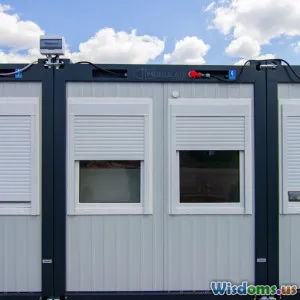
A StepByStep Guide to NetZero Home Construction
9 min read Discover how to build a NetZero home with this comprehensive step-by-step guide blending sustainable design and cutting-edge technology. (0 Reviews)
A Step-by-Step Guide to NetZero Home Construction
Introduction
In a world increasingly defined by environmental challenges and the urgent need to reduce carbon footprints, the concept of NetZero homes is emerging as a revolutionary solution. Imagine living in a home so energy-efficient that it produces as much energy as it consumes — a home that not only reduces environmental impact but also cuts energy expenses to near zero. NetZero home construction combines smart technology, sustainable materials, and innovative design principles to not just meet today's housing needs but sets the stage for a resilient future.
But how do you go from concept to reality? This guide takes you through the essential steps of constructing a NetZero home, demonstrating that with the right knowledge and commitment, anyone can create a sustainable sanctuary.
Understanding NetZero Homes
What is a NetZero Home?
A NetZero home is designed to balance its energy usage with renewable energy production, effectively achieving net zero energy consumption annually. This means the home generates sufficient clean energy — often through solar panels or wind turbines — to offset its total energy use, including heating, cooling, lighting, and appliances.
According to the U.S. Department of Energy, a NetZero building reduces energy bills drastically while promoting environmental sustainability.
Why Build a NetZero Home?
- Environmental Impact: Buildings account for nearly 40% of global energy-related carbon emissions (IEA, 2021). NetZero homes play a critical role in reducing this footprint.
- Cost Savings: Though the upfront cost can be higher, homeowners save tens of thousands over decades due to negligible power bills.
- Resilience & Comfort: Such homes maintain comfortable indoor temperatures year-round and often incorporate better air quality systems.
Step 1: Site Selection and Orientation
Choosing the right location is foundational. NetZero design leverages site-specific natural resources.
- Solar Access: Prioritize locations with maximum sun exposure to optimize solar panel efficiency. For example, orienting the home southwards (in the Northern Hemisphere) ensures optimal solar gain.
- Climate Consideration: Determine regional climate—cold, hot, humid, dry—to decide on insulation and ventilation strategies.
- Local Regulations: Check zoning laws and renewable energy incentives. Many states offer tax credits for NetZero construction.
Example: The “Zero Home” project in Colorado utilized the mountain region’s solar potential for year-round energy efficiency, integrating site location and topography.
Step 2: Designing for Efficiency
Passive Design Principles
Start by maximizing energy conservation through smart architectural design.
- Insulation: Use high-performance insulation materials to reduce heat loss. Options include spray foam, cellulose, or rigid foam panels.
- Windows & Glazing: Double or triple-pane windows with low-emissivity coatings minimize heat transfer. Strategic placement reduces heating or cooling load.
- Air Sealing: Sealing cracks and gaps is crucial. A controlled airtight envelope reduces drafts and energy waste.
Building Envelope Optimization
The building envelope acts as a barrier against energy loss.
- Employ continuous insulation layers.
- Utilize thermal mass materials like concrete or stone to moderate temperature fluctuations.
Insight: The Passive House methodology, developed in Germany, is a leading example emphasizing airtightness and near-zero energy consumption.
Step 3: Selecting Sustainable Materials
Materials contribute significantly to a home's embodied carbon.
- Certified Wood & Reclaimed Materials: Reduce ecological impact by sourcing sustainably harvested wood or reusing materials.
- Low VOC Paints & Sealants: Improve indoor air quality by avoiding toxic compounds.
- Durable & Locally Sourced Materials: Minimize transportation emissions and extend lifespan.
Example: The Bullitt Center in Seattle incorporated reclaimed timber and non-toxic finishes to set a standard for sustainable building.
Step 4: Energy-Efficient Systems
Beyond construction techniques, the right systems help optimize energy consumption.
HVAC Systems
- Choose high-efficiency heat pumps for heating and cooling.
- Incorporate heat recovery ventilation systems (HRVs) to maintain fresh air without energy loss.
Lighting
- Use LED fixtures with smart sensors to minimize energy use.
Appliances
- Select ENERGY STAR certified appliances, known for low energy consumption.
Fact: The U.S. EPA states ENERGY STAR appliances use 10-50% less energy depending on the product.
Step 5: Renewable Energy Integration
Harnessing renewable energy is the heart of NetZero homes.
Solar Power
- Photovoltaic (PV) Panels: Most common for electricity generation.
- Solar Water Heating: Supplement hot water needs efficiently.
Other Renewable Systems
- Wind Turbines: Suitable in windy areas.
- Geothermal Energy: Uses stable underground temperatures for heating/cooling.
Energy Storage
Batteries help store excess energy generated during peak production.
Real-World Example: The Tesla Model Home in California integrates rooftop solar with Powerwall storage to manage energy throughout the day.
Step 6: Smart Home Technology and Monitoring
Smart technology enhances energy management.
- Energy Management Systems (EMS): Allows monitoring and optimizing consumption in real time.
- Smart Thermostats: Adapt temperature settings based on occupancy, reducing energy waste.
- Automation: Automated lighting, shading, and appliances maximize efficiency.
Quote: As Builder magazine highlights, "Smart tech turning homes into energy-savvy organisms is the future of sustainable construction."
Step 7: Certification and Performance Verification
Seek third-party certifications to validate your NetZero home’s performance.
- Passive House Certification: Focuses on design and airtightness standards.
- LEED Certification: Covers sustainability more broadly.
- Zero Energy Ready Home (DOE): US Department of Energy standard for high efficiency and renewable readiness.
Performance monitoring over a year confirms if the home meets zero energy criteria, adjusting system operations if necessary.
Challenges and Considerations
While the benefits are clear, consider:
- Initial Investment: Upfront costs can be 5-20% higher but with long-term savings.
- Technical Expertise: Collaboration with architects and engineers familiar with NetZero principles is crucial.
- Local Climate Constraints: Extreme climates require specialized design.
Despite these, many projects demonstrate a break-even in 6-10 years.
Conclusion: Building a Sustainable Future
Constructing a NetZero home is more than a trend — it’s a vital step toward sustainable living that benefits homeowners and the planet alike. By following a systematic approach: prioritizing site, design, materials, efficient systems, renewable energy, and smart technology, you can build a home that embraces innovation and conservation.
As global initiatives push for carbon neutrality, NetZero homes position their owners not just as energy consumers, but as proactive stewards of the environment.
Embrace the journey to building your own NetZero home—because the future of comfortable, affordable, and responsible housing is within your reach.
Additional Resources
- U.S. Department of Energy – Zero Energy Ready Home Program
- Passive House Institute
- Energy Star Certified Homes
Written by an AI enthusiast committed to sustainable architecture and green technologies.
Rate the Post
User Reviews
Popular Posts


















